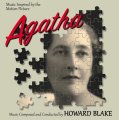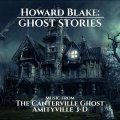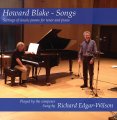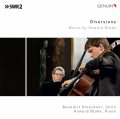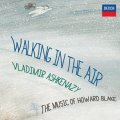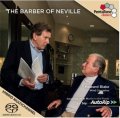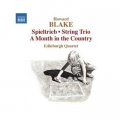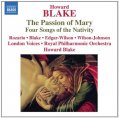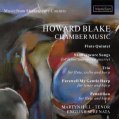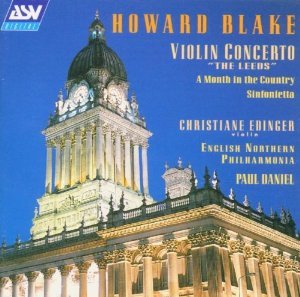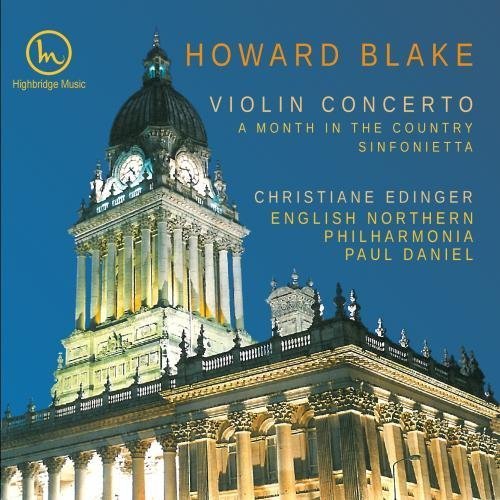 Highbridge Music Ltd.
Highbridge Music Ltd.
Studio 6, 18 Kensington Court Place, London W8 5BJ, UK
Email: howard@howardblake.com
*VIOLIN CONCERTO 'Requiem to the memory of a most true and saintly soul' op.441 (July 1992)
Available on ASV digital CD record label DCA 905 (1994) stereo.
Published by: Highbridge Music LtdCommissioned by: Bernard Atha - on behalf of The City of Leeds to celebrate the 100th anniversary of its charter
Instrumentation:
Concerto for violin and orchestra
2(=picc+afl).2(II=ca).2(II=bcl).2.cbsn - 4400 - timp - perc(1): tam-t/cyms/susp.cym/tgl/glsp - harp - strings
[Key to Abbreviations]
Duration: 35 mins
First Performance: Christiane Edinger The Northern Philharmonia conducted by Paul Daniel at Leeds Town Hall 6th February 1993.
Sheet Music Available
Full score for hireStudy score for hire
Orchestral parts for hire
Recordings Available
Violin Concerto "The Leeds", A Month In The Country, Sinfonietta
Released: 1994
Recorded: 1994
Artists: Christine Edinger (violin), Paul Daniel (conductor), English Northern Philharmonia
Available from: ASV Records ASV Records
Released: 1994
Recorded: 1994
Artists: Christine Edinger (violin), Paul Daniel (conductor), English Northern Philharmonia
Available from: ASV Records ASV Records
Violin Concerto "The Leeds"; A Month in the Country; Sinfonietta (digitally remastered 2012)
Released: 2012
Recorded: 2012
Artists: Christiane Edinger (violin), English Northern Philharmonia conducted by Paul Daniel
Available from: Amazon UK Amazon US ASV Highbridge Music
Released: 2012
Recorded: 2012
Artists: Christiane Edinger (violin), English Northern Philharmonia conducted by Paul Daniel
Available from: Amazon UK Amazon US ASV Highbridge Music
Christiane Edinger (solo violin), The Northern Philharmonia conducted by Paul Daniel. ASV CD DCA905 1994
Revelations ASV compilation CD 1997
Movements
-
1:
Allegro Assai
19 minutes
54 seconds
-
2:
Adagio
7 minutes
09 seconds
-
3:
Allegro con Brio
5 minutes
33 seconds
Notes
Composer's note: In April 1991 I composed and recorded a 'cantata' overnight as a challenge for the BBC TV programme 'Challenge Anneka'. It was done for a good cause, to help promote 'The Paralympics' and a large crowd of participants and fundraisers joined us at ITV in London to watch the first broadcast of it at 11.15pm that night April 17th. I found myself talking to Bernard Atha who ran the Arts in Leeds. He was amazed by it and wondered, since I could write a cantata overnight, whether I could compose a full-scale violin concerto for Nigel Kennedy in time for the centenary of Leeds in early 1993. I said that I had always longed to write such a work and would be delighted. Arrangements began but although I knew Nigel I couldn't get any response from either him or his agent at that time. Years later his manager wrote and said that when he moved offices he found my letter behind the radiator! That September I was visiting a music festival in a castle near Steyr in Austria and heard some terrific violin practise coming from the next room. I was so excited by the sound that I sat down and sketched out the opening theme of the concerto, taking it to the terrace where the violinist Christiana Edinger was having coffee. She said 'Let's try it' and our host Ilona von Ronay suggested that we go to Bruckner's house in the village where there was a good piano. On playing it Christiane declared she would love to give the premiere. I began work and finished the orchestration the following July. Christiane then began rehearsing it, giving the first performance in February 1993.
My inner, personal motivation for composing the concerto was quite different. My mother, who had played and taught me the violin, had died on 23rd September 1990 to my most heartfelt grief. On the title page of the published concerto is placed a dedication 'To the memory of a most true and saintly soul', which refers to my dear mother. The entire concerto is therefore, whilst being commisssioned by the city of Leeds. dedicated to my mother. The slow movement Adagio calma may be regarded as a requiem for her. The concerto might in fact be more aptly named: 'Concerto da Requiem'.
Top review from United Kingdom 'Ballerina':
Performances
| 14th May 2016 - 7th February 2018 |
Full-evening ballet 'Eine Frau Ohne Namen' (A woman without a name) has music by Howard Blake, the score consisting entirely of excerpts from his choral and orchestral works, particularly the oratorio 'Benedictus' (opus 282) Ballet choreographed and directed by Robert North., First performance Monnchen Gladbach Opera 14th May 2016 Final performance Krefeld Opera 7th February 2018 |
| 16th September 2015 | HOWARD BLAKE PIANIST IN A RE-ISSUE OF HIS RECORDING OF HIS OWN CONCERTO FOR PRINCESS DIANA WITH THE PHILHARMONIA ORCHESTRA GAINED 5 STARS AND THE COMMENT ON HIS VIOLIN CONCERTO AS BEING 'ONE OF THE MOST MOVING WORKS OF ITS KIND IN THE LAST 100 YEARS' (BALLERINA - AMAZON), ROYAL FESTIVAL HALL
Top review from United KingdomVerified Purchase |
| 4th December 1997 | Katerina Andreasson, The Philharmonia, Royal Festival Hall |
| December 1996 | Lorraine McAslan, Royal Philharmonic Orchestra, Marble Hill Concerts |
| 20th August 1994 | Christiane Edinger, Howard Blake conducting The English Sinfonia (first London performance), Kenwood Lakeside Concerts |
| 6th February 1993 | English Northern Philharmonia / Christiane Edinger / Paul Daniel, Town Hall, Leeds |
Reviews
"Eine Frau ohne Namen" - ein Ballett von Robert North mit Musik von Howard Blake.
Das Leben einer Frau von ihrer Geburt bis zum Tod ist Thema eines neuen Ballettabends von Robert North. Im Theater Mönchengladbach wurde die Uraufführung dieses Werkes vom Publikum begeistert gefeiert. Dass der Abend zutiefst berührt ist neben der eindrucksvollen Choreografie vor allem der Musik zu verdanken. In enger Zusammenarbeit mit dem Ballettdirektor hat der britische Komponist Howard Blake verschiedene Teile aus seinen Werken zu einem faszinierenden Klangteppich zusammengefügt. Neben großem Orchester mit ausgedehnten Streichersoli kommt im letzten Teil auch ein Chor zum Einsatz.
Der Abend beginnt musikalisch mit einem Sopransolo (Sophie Witte), das sich von zarten Tönen zu ausdrucksvollem Gesang steigert. Die Sängerin steht am linken Bühnenrand und begleitet gemeinsam mit den Streichern der Niederrheinischen Sinfoniker den Prolog. Vor einem roten Hintergrund, auf dem als Sinnbild des Lebens eine Kreisform zu erkennen ist, erwachen die Tänzer zum Leben. Sieben Männer und Frauen, in schlichte graue Trikots gekleidet, tanzen gemeinsam, dann in Gruppen getrennt und schließlich wieder zusammen. In einer für North charakteristischen klaren Ausdrucksform, in der sich stets klassische und moderne Elemente des Tanzes mischen, wird vom Ursprung des Lebens erzählt. Männliche und weibliche Gene ziehen sich an, vereinigen sich, Leben entsteht.
Wo Leben ist, ist auch der Tod. Farbe und Licht wechseln in tiefes Blau und in einer kurzen Sequenz wird der Tod einer männlichen Figur betrauert. Am Ende des Prologs erscheint ein kleines Mädchen aus einem Tunnel heraus, den die Tänzer gebildet haben. Mit seinen Eltern läuft es im Kreis, ein größeres Mädchen wir eingewechselt, schließlich richtet sich eine in Rot gekleidete Frau (Karine Andrei-Sutter) im Zentrum der Bühne auf. Sie ist von einem schwebenden Metallkreis umgeben, der im Verlauf des Stücks noch eine wichtige Rolle spielen wird. Das Leben der Frau beginnt. Sie ist als allgemeines Sinnbild zu verstehen und bleibt daher namenlos. Auch bei den weiteren Figuren wird auf individuelle Namen verzichtet.
Da sind zwei Freunde (Takashi Kondo und Guiseppe Lazarra), die sie durchs Leben begleiten, eine Freundin (Elisa Rossignoli) taucht auf, die später zur erbitterten Rivalin wird. Vertrauensvoll und von einer zurückhaltenden Zuneigung ist die Beziehung zu dem Jugendfreund (Raphael Peter) gekennzeichnet, heftige Leidenschaft charakterisiert die Begegnung mit dem ersten Ehemann (Alessandro Borghesani). Kinder werden geboren und bald verlässt er sie wegen der Freundin. Eine banale alltägliche Geschichte, die allerdings sehr dicht und emotional erzählt wird. Das Bühnenbild bleibt bis auf wenige Farb-und Lichtwechsel abstrakt, die Kostüme sind der heutigen Zeit angepasst (Ausstattung Udo Hesse).
Zwei Sätze aus Howard Blakes Violinkonzert bieten den perfekten musikalischen Rahmen dazu. Unter der Leitung ihres Kapellmeisters Alexander Steinitz spielen die Niederrheinischen Sinfoniker hoch konzentriert und engagiert. Im hoch emotionalen Violinsolo (Philipp Wenger) spiegeln sich die Qualen der verlassenen Frau wider. Innerhalb des Metallkreises agiert sie wie eine Gefangene, die keinen Ausweg findet. Nicht nur in dieser Szene beeindruckt Karine Andrei-Sutter mit ihrer feinnervigen und zugleich so intensiven Körpersprache. Die langjährige Solistin des Ballettensembles feiert mit dieser Rolle, in der sie alle Facetten zeigen kann, einen glanzvollen Abschied von der Bühne. Aus der Krise führt der Weg zur Kunst. Gegen Ende des ersten Teils wird die Frau eine gefeierte Schriftstellerin, der Jugendfreund zum zweiten Ehemann. Der erste Mann und die Freundin tauchen als schmerzhafte Erinnerungen immer wieder auf. Der zweite Teil zeigt die Frau bereits am Ende ihres Lebens.
Der Dynamik des Lebens folgt eine eher elegische und versöhnliche Stimmung. Jetzt mit grauem Haar bekräftigt das Ehepaar im Tanz noch einmal seine Zuneigung, gibt es auch die Aussöhnung mit der Freundin. Der Tod erfolgt plötzlich am Schreibtisch, was den Abend aber noch nicht beendet. Denn in einem an den Prolog anknüpfenden Schlussteil wird der Übergang vom physischen Tod in ein anderes Leben thematisiert. Robert North’ Überlegungen sind hier eindeutig vom christlichen Abendland geprägt. Nach einem Zwischenzustand in Leere und Dunkelheit begleitet ein Engel (Viktoria Hays) die Frau in eine andere Sphäre. Die reduzierte Architektur eines Gewölbes mit Empore sowie die in Pastelltönen gehaltenen, schlichten Kostüme lassen an Renaissancebilder denken. Darauf abgestimmt ist auch die Musik, die mit einem wunderbaren Viola-Solo (Albert Hametoff) beginnt und dann Teile aus Blakes Oratorium „Benedictus“ verwendet. Der lateinische Gesang des gemischten Chores (Einstudierung Maria Benyumova) verbreitet eine feierlich-sakrale Atmosphäre, zu der die wieder sehr dynamische Choreografie einen spannenden Kontrast bietet. Mit Drehungen und Sprüngen und in unterschiedlichen Konstellationen scharen sich achtzehn Tänzerinnen und Tänzer als Himmelswesen um die jetzt weiß gekleidete Frau, die schließlich Teil von ihnen wird.
Die einfache Geschichte bekommt so einen überzeitlichen Charakter, Musik und Tanz verschmelzen zu einen eindrucksvollen Gesamtkunstwerk. Dass das alles nicht in Kitsch abdriftet sondern sehr berührt, ist der Kunst von Robert North zu verdanken. Er versteht es, mit Tanz Geschichten zu erzählen, prägnant und voller Poesie
Stück Das Ballett „Die Frau ohne Namen“ mit Musik von Howard Blake wird das nächste Mal am Donnerstag, 19.Mai, um 19.30Uhr am Theater Mönchengladbach an der Odenkirchener Straße 78 gezeigt.
Musikalische Leitung Alexander Steinitz
Choreografie Robert North
Choreografieassistenz Sheri Cook
Bühne und Kostüme Udo Hesse
Dramaturgie Regina Härtling
Michaela Plattenteich, West Rheinischer Zeitung, 16/5/2016
The ASV disc of the Violin Concerto has been written about with more insight than I can muster by Ian Lace. It was written for Nigel Kennedy but premiered by Christiane Edinger in Leeds whose city fathers commissioned the piece. It stands in the central pathway of the great English tradition of music for violin and orchestra. At various times its wondrously presented ideas sing out in exultant company with The Lark Ascending and with the concertos of Walton, Elgar and Delius. It is however no pastiche and is deeply affecting in its own right. I only mention these other works to give you some idea of the sound-world. There's a tender Adagio and an Allegro con brio that is chipper, exultantly pointed and light-on-the-feet. This work belongs among my favourite violin concertos alongside Prokofiev 1, the superb Ivanovs, the Sainsbury and the Sibelius.
jonathan woolf, Musicweb-international, 9/1/2010
If you like lush, Romantic music, look no further. This is a magnificent, accessible concerto from the composer of the music for the highly successful animated film of The Snowman. It is the sort of music that any film producer would give his eye teeth for - dramatic, heroic, atmospheric and lyrical with beautiful soaring melodies but above all it is resolutely tonal. It was commissioned by Leeds City Council for the Leeds 1993 City Centenary, hence its title, although judging from Howard Blake's own CD booklet notes, there is no programme. It is absolute music to be enjoyed in its own right; nonethless, one is occasionally tempted to guess at some extra musical influence - for instance, the a robust passage for brass in the lengthy first movement that might describe the forthright but dependable Yorkshire personality. Christiane Edinger rises, with aplomb, to its technical challenges, especially in the bravura third movement with its quadruple stoppings, pizzicati and dazzling broken chords. Daniels provides a thrilling and sensitive accompaniment. The sound throughout this programme is excellent.
music-web international, International MusicWeb, 1999
Christiane Edinger is the soloist in what proves to be an inspired performance, 'caught on the wing' to join a select group of very special first recordings made over the years. The work, written in the received tradition of Elgar, Vaughan Williams, Walton and, more recently, Christopher Headington, has a ready and appealing melodic impulse, and the playng here is as intense and communicative as it is spontaneous. The slow movement, lke the haunting close of the opening movement, brings some exquisitely tender pianissimo playing from the soloist (matched by the orchestra), and she is equally at home in the vigorously extrovert dancing finale which has much in common with the last movement of Dvorak's concerto. The only snag is the very wide dynamic range of the recording: this means that the spectacular bursts of percussion interrupting the reverie which opens the first movement and which reappears at the climax of the Adagio, are almost overwhelming when one has set the volume level to accommodate the music's quieter moments. The microphones are not always entirely flattering to the solo violin; but, in spite of these criticisms, this recording is a heartwarming experience. A Month in the Country brings moments of comparable bitter-sweet elegiac feeling. It is most sensitively played, as is the brass Sinfonietta, sonorous and jolly by turns. In terms of overall concert-hall realism the recording is impressive and the CD is strongly recommended; it would have earned a Rosette were it not for the (not entirely insoluble) problem of accommodating both the loudest and the quietest music on a single volume setting for comfortable domestic listening.
The Penguin Guide to Compact Discs, 3/1/1995
Inspired, intense, yet infused with spontaneous feeling. The first movement.. is very appealing. The performance brings a moment of utter magic when, after the solist's hauntingly introspective (written) cadenza, the alto flute floats the main theme exquisitely over gently violin arpeggios. The slow movement again brings a hushed opening, unforgettable when the violinist, following a big tutti, takes up the main theme on a thread of tone ending with a breathtaking pianissimo. The finale is in the best 'dancing' tradition of the great concertos from Mozart and Beethoven onwards.
Ivan March, Gramophone, 12/1994
Not only has Blake created one of the most radiantly beautiful concertos ever written, wirth a slow movement of unsurpassed loveliness, he has shown that 'Modern' Music can be immediately enjoyable.
Classical Music, 12/1994
This is unequivocally great music, accessible, expressive and often ravishingly beautiful.
The Strad,
Related Works
'VIOLIN CONCERTO (THE LEEDS) ARRANGED FOR VIOLIN AND PIANO'
op.471A
(1994)
An arrangement by Helen Burrows
An arrangement by Helen Burrows
'EVA'
op.481
(March 1996)
A ballet in 3 acts for orchestra, solo violin and satb chorus - the story of 'everywoman' choreographed by Robert North for Gothenburg Opera House
A ballet in 3 acts for orchestra, solo violin and satb chorus - the story of 'everywoman' choreographed by Robert North for Gothenburg Opera House

